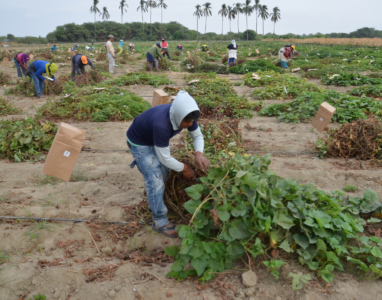
Extreme weather events and other effects of climate change already challenge farmers’ ability to grow enough food, which is expected to become more challenging as the atmosphere warms. One study predicted that with each degree (°C) increase in the global mean temperature, yields of major staples could decrease by between 3 and 7.4 percent, without more climate-smart varieties and technologies.
The good news is that sweetpotato could help fill the gap, since that robust root crop has the potential to produce food under high temperatures, according to the results of research published this week in Nature Climate Change. The article’s authors report that sweetpotato biodiversity includes significant heat tolerance, which could be harnessed to boost food and nutrition security well into the future, as rising temperatures threaten the productivity of other staples.
“Sweetpotato is definitely a climate resilient crop, and breeders can use the species’ biodiversity to make it even more resilient,” said Bettina Heider, a researcher at the International Potato Center (CIP) and lead author of the article published in Nature Climate Change.
To assess sweetpotato’s capacity to cope with high temperatures, Heider and other scientists from CIP, the French Agricultural Research Center for International Development (CIRAD) and the French National Research Institute for Sustainable Development (IRD) screened an extensive sampling of the species’ agrobiodiversity, from the CIP genebank in Lima, Peru. The genebank safeguards one of the worlds largest collections of sweetpotato biodiversity – more than 5,500 accessions from 50 countries in Africa, Asia and the Americas – in trust for humanity. The researchers planted 1,973 of those accessions in the desert of northern Peru to evaluate their response to heat stress.
During two crop cycles, in the southern hemisphere winter and summer – when mid-day temperatures can reach 40 °C – the scientists monitored the plants’ development over the course of 120 days using hand-held instruments and drones. Upon harvesting, they assessed yields, the number and quality of sweetpotatoes, and the amount of foliage each plant produced.
“The advantage of remote sensing technology is that we were able to get a thermal snapshot of 1,973 accessions at a precise moment,” Heider said.

She explained that this enabled the team to measure the area and temperature of the plants’ foliage and other factors that help them cope with heat stress, which the scientists then correlated with yield parameters. At the end of the field study, they not only identified 132 heat tolerant accessions, they also documented plant characteristics and responses to heat stress – such as lowering the temperature of the leaf canopy – that can be used to predict whether a cultivar will produce good yields under high temperatures. Breeders can use those predictors to select parents and offspring when developing heat tolerant varieties, whereas farmers or agronomists can use them when choosing resilient sweetpotato varieties with high yield stability for the climatic conditions in their region.
“Sweetpotato has impressive potential for adaption to climate change,” said Heider.
She added that comparable research should be done for salt and drought tolerance, to identify accessions that can be used in breeding varieties that will thrive in future climates, or areas where harsh environmental conditions already hinder food production.
Heider explained that while the field study of 1,973 groups of plants was a massive undertaking – made possible by support from the CGIAR Research Program on Roots, Tubers and Bananas – it produced insights on plant responses to heat stress and predictors that scientists could apply to other crops as they develop climate-resilient varieties.
“This study provides a clear demonstration that the diversity within a crop species may hold important traits that breeders can use for adaption to climate change,” she said.

Heider explained that many of the most heat tolerant sweetpotato accessions were from Asia, though a significant number also came from South America, and a few from Africa.
One fortuitous discovery of the study was that some of the most heat-tolerant sweetpotatoes are orange-fleshed, which means they contain high levels of beta carotene: the precursor of vitamin A. One small orange-fleshed sweetpotato can satisfy the daily vitamin A needs of a child five years old or younger, reducing their risk of health problems ranging from infections to blindness.
In an effort to reduce the number of women and children afflicted by the health effects of vitamin A deficiency, CIP and partners have gotten planting material for nutritious and resilient orange-fleshed sweetpotato varieties to more than 6.5 million farming households in Africa and Asia over the past decade.
The identification of heat tolerant sweetpotatoes and characteristics that can guide breeders as they develop resilient varieties, of sweetpotato or other crops, will contribute to global efforts to improve the food and nutrition security of millions of people at risk of malnutrition, and the transition toward a healthier, more climate resilient food system.
